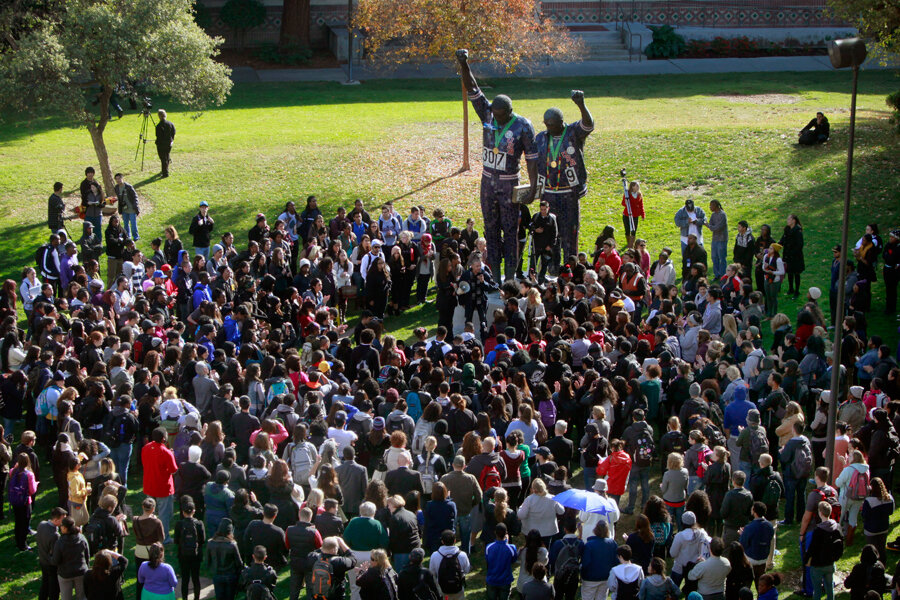Hate-crime allegations: four white students at San Jose State charged
Loading...
Four white students at San José State University in California have been suspended and charged with misdemeanor battery and hate crimes against an African-American student who shared their dorm suite. Police say the harassment ranged from displaying a Confederate flag and white-supremacist symbols to putting a bicycle lock around his neck.
A university police report says the white students referred to their behavior as “pranks” and “jokes.” The students reportedly referred to their suite-mate as “Three-fifths” and “Fraction,” a reference to how the US government historically counted slaves.
The accusations came to light after the African-American student’s parents reported seeing the flag and a racial epithet in the suite.
San José State students protesting racially biased hazing rallied on Thursday at the site of a campus statue celebrating an expression of black power during the 1968 Olympics.
The incident may be surprising to some who see the United States as having progressed beyond such overt displays of racism. But to those who track racial bias, it’s another indicator that such progress is slow in coming.
“This is one of the more disturbing incidents of racial intolerance that I’ve seen recently, but it follows a pattern on college campuses,” in which some students see racist behavior as acceptable and even funny, says Lecia Brooks, outreach director for the Southern Poverty Law Center.
Reports of Confederate flags on campus are common, Ms. Brooks says, and sporadic incidents have included hate-filled vandalism, students wearing blackface on Halloween, and groups making a game of chasing immigrants on campus.
Increasing racial isolation in society, as well as the lack of critical mass of students of color on many campuses, probably contributes to the problem, Brooks says. (The majority of students at San José State, however, are students of color.)
The Southern Poverty Law Center in Montgomery, Ala., has counted several white-pride campus groups in its tracking of hate groups in recent years, because of their leaders’ ties to white-supremacy organizations.
In 2011, the Federal Bureau of Investigation reported 6,222 hate-crime incidents in the US, about 47 percent of them racially motivated. Just over 9 percent of the total number of incidents took place at schools or colleges. Those numbers are down somewhat from 2008, when there were 7,783 hate crimes tracked by the FBI, nearly 12 percent of them at schools or colleges.
In the past 20 years, the number of racial incidents on campuses appears to have remained fairly steady, says Robert Bruce Slater, managing editor of The Journal of Blacks in Higher Education, which has tracked such incidents through press reports.
A multicultural residence on the campus of Lehigh University in Bethlehem, Pa., was recently egged and spray-painted with graffiti that included racial slurs – one of six racial incidents on campuses noted on The Journal of Blacks in Higher Education website just this month.
“Frankly, there’s probably many more that actually happen than ever get reported in the press,” Mr. Slater says. The San José example is “hard to believe in this day and age,” he says, but such incidents happen “in society as a whole, and colleges are a subset of that.”
Of the four San José State students charged, three are adults and are expected to be arraigned in January, according to San Jose Mercury News. If convicted, they could face up to a year in jail. The fourth student is a juvenile.
The African-American student, in an interview with the Mercury News, said he didn't report the situation to campus police in hopes that the behavior would stop.
“I am outraged and saddened by these allegations. They are utterly inconsistent with our long cherished history of tolerance, respect for diversity and personal civility,” said San José State’s president, Mohammad Qayoumi, in a statement. “We speak very directly to all freshmen about discrimination and harassment during orientation and at hall meetings. We will re-examine our diversity programs and safety measures within campus housing and throughout the university.”
• Material from the Associated Press was used in this report.






